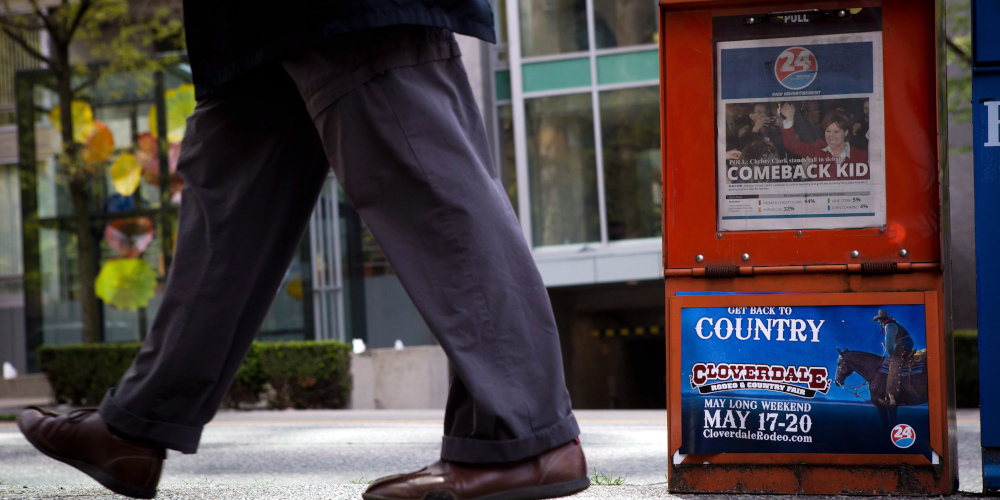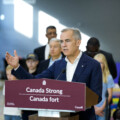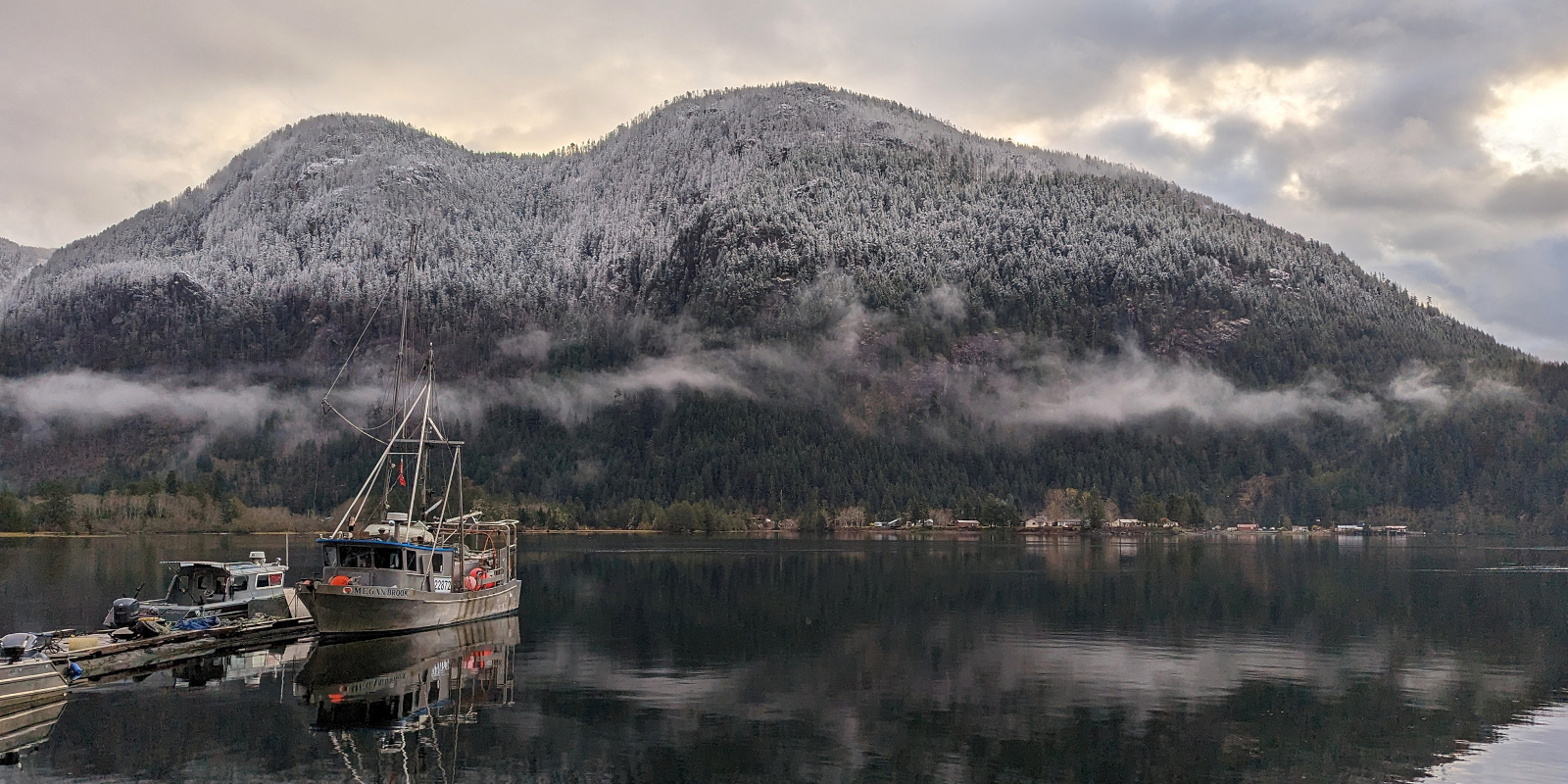The news media in Canada is in crisis. Policy responses to date are failing to solve for the information that citizens need to make informed decisions about important issues and debates. The Future of News series brings together leading practitioners, scholars, and thinkers to imagine new business models, policy responses, and journalistic content that can support a dynamic future for news in Canada.
Twenty years ago, when The Tyee launched in 2003, it encouraged readers to spread the word of British Columbia’s latest digital magazine by printing off and passing out physical copies of its articles.
Two decades is a blip for legacy Canadian newspapers, born in the 1800s. But it’s an eon in digital media, making The Tyee a bridge between two very different eras of news. Amid decades of change in how readers are reached, its emphasis on interacting with them has remained constant.
Founded by editor-in-chief David Beers after a wave of layoffs took his job as The Vancouver Sun’s features editor, The Tyee (“Tie-yee”) was envisioned as a progressive left-leaning alternative to the province’s mainstream news sources. Its name is a reference to the “feisty and free” Chinook salmon, a creature emblematic of values Beers describes as “a commitment to high journalistic standards, focusing on our part of the country, holding power accountable, and profiling positive change.”

Paying for everyone
As most publications employ hard paywalls or cling to ad-based models, The Tyee offers memberships without locking away any content. This isn’t unheard of— U.K. newspaper The Guardian, for example, does something similar—but it’s rare enough to be held up as something of a news unicorn. In 2015, The New Yorker called The Tyee “a fascinating case study” in local journalism. A 2010 NiemanLab profile, which said The Tyee “pounds out left-leaning daily content with a Slate-y verve,” highlighted its “kooky” fundraising methods that included renting out unused office space.
Today, about half of The Tyee’s funding comes from regular and one-off donors, which publisher Jeanette Ageson says numbered just shy of 10,000 people last year. The Tyee also receives a chunk of government funding from the Local Journalism Initiative and tax credits, and a sliver of ad revenue. The rest of the money comes from Eric Peterson and Christina Munck. In 2001, Peterson sold his medical imaging company, Mitra, for about $300 million. The couple has been involved in a variety of philanthropic efforts ever since.
Peterson and Munck have no editorial input but, to state the obvious, not every publication can rely on wealthy patrons to keep the lights on. Cognisant of this lynchpin, The Tyee has been working to reduce its financial reliance on the family.
“Last year we got [Peterson and Munck] to under 20 percent of our budget, which is important because that’s what we need to keep our Registered Journalism Organisation status,” says Ageson. The federal designation entitles recognized outlets to government funding. “And that’s our long-term plan, to reduce dependency and keep growing our donors. 2022 was the first year we passed a million dollars in donor revenue.”
The Tyee became a non-profit in 2022. While this was more of a technical shift than a philosophical restructuring, it will allow the publication to issue tax receipts. This, Ageson hopes, will attract additional donors.
“If you give, you’re keeping it free for everybody. That’s always been one of the selling points,” Ageson says. “A paywall sacrifices reach. For certain publications, the exclusivity is the point. It gives the reader a competitive advantage, that works really well with business or financial publications. But we deal with public interest issues. Part of the value proposition is that it will be part of the public conversation. That seems to resonate with people.”
Chad Skelton, a journalism instructor at Surrey’s Kwantlen Polytechnic University, says this model can change how people view the news, and that it’s a shift that seems necessary for the industry’s survival.
“News organisations using the donation model have had a fair amount of success,” Skelton says. “If you’re paying for a subscription, you think about whether you’re getting enough value. With a donor model, you want to support the mission. It’s not what you get, it’s what you give back to the community. It’s almost like donating to the symphony or a homeless shelter.”
Soliciting opinions
To convince your readers you offer a public good, you have to understand their worldview. The Tyee is therefore enthusiastic about soliciting reader opinions.
“[Journalist] Jennifer Brandel says, ‘Don’t be an askhole,’” Ageson explains. “If you’re asking for input from your audience, make sure you’re actually using it. We get a steady drip of emails. People tell us what they see as missing.”
Elections are particularly fertile ground for audience polling, and The Tyee has a “quite detailed process” to determine what readers see as important during the campaign.
“We give readers an open text box, so we’re not feeding people answers. We’ll see if a lot of people organically mention the same issue. We pick out things we’re well-placed to report on. That can create a mandate for our newsroom,” Ageson says. “People like to be heard, they like to take part. It’s also a great way to ask people for their email addresses.”
Beyond elections, steady reader feedback ensures journalist coverage matches reader interest. Notably, The Tyee has a significant climate portfolio, mirroring other indie publications like The Narwhal. Ageson says reader questions like, “What needs to be done to transition to a cleaner economy?” are consistent.
“Every time we survey our audience and ask what issue deserves more support, climate is usually one of the top answers,” Ageson says. “People want reporting to add to their understanding and identify what can be done.”
This, Skelton says, is the strength of a membership model. Digital media can meet demands that legacy publications, which skew towards an older readership, may not be aware of.
“Being an instructor, I spend all day with [younger people],” Skelton describes. Climate change really does have this existential bent when you talk to them. Mainstream organisations have been slow to pick up on how important that issue is to some readers. Online publications have done a better job of tapping into that.”
With social media traffic moribund, publications need to ensure readers have a real reason to visit their website. Traffic sources can vary wildly with time—Flipboard, a news and social aggregator, has become a notable source of traffic for The Tyee—but Ageson has noticed direct traffic is increasing. Or, in her words, “People are making an appointment with our site.”
While Skelton is a fan of this give-and-take between reader and publication, it does have a downside, as outlets can feel they owe their audience a certain perspective.
“It comes with risks in that you want to support the news organisations you think are in your corner,” the instructor says. “That can make it harder for publications to run stuff that challenges their audience.”

Echoing your readers
All publications have their perspectives, and it is reasonable to say The Tyee maintains a left-wing one. Skelton finds their work “well-reported and fair.” But he does see their model as one that touches on a broader risk for the future of Canadian media.
“I do worry that the left-of-centre people only read and donate to The Tyee, the far-right read The Rebel, the really left-wing people read Ricochet. I don’t want to over-romanticise the way it was before, but if we expect news organisations to be in our corner, and if there are incentives to flatter their audience’s preconceptions, that can create an unhealthy environment where we only read the organisations we support.”
Wanting to be read and paid is a reasonable goal, and this is a hypothetical future that goes well beyond just The Tyee. But as distrust in the media grows, and as every publication claims to be a unique panacea to misinformation, it does suggest something of a siloed future. At the very least, however, that’s a future where news still exists.
“I’ve become more laissez-faire, partially because of the crisis in the journalism industry,” Skelton says. “I see The Tyee doing high-quality work that otherwise would not exist. It sometimes creates a bit of an echo chamber, but news organisations are always fooling themselves into thinking their story selection is some ideal of objectivity and fairness. They’re serving what their readers care about.”
These concerns aside, The Tyee’s symbiotic relationship between reader and publication appears to be working so far.
“The Vancouver Sun, CBC, and Global used to dominate the Webster Awards, the big B.C. journalism awards,” Skelton says. “Now they’re dominated by The Tyee and places like The Narwhal. And the Vancouver Sun will be shut out. That would have been unheard of even 10 years ago.”
An idiosyncratic future
Beyond their ideological leanings, Skelton sees digital publications like The Tyee as homes for journalists who don’t fit the mould elsewhere.
“The Tyee’s left-of-centre, but it’s also just idiosyncratic. They let talented people run with their interests,” Skelton says. “Christopher Cheung, he’s done a lot of articles about the immigrant community. Those stories don’t have ideology, they’re just interesting. If you’re a young, talented journalist who doesn’t fit into existing beats at the Vancouver Sun or The Globe and Mail, these smaller pubs are willing to take risks.”
That’s reflected in The Tyee’s most successful 2023 stories. Public issues and politics—police misconduct, housing, plenty of shots at neighbouring Alberta—dominate. However, a deep look at an all-but-abandoned mining town and a story about a distinctive glass house in Burnaby also found success. That suggests an audience appetite for the sort of cultural reporting mainstream publications have retreated from.
“Some donor and philanthropically supported organisations…it’s all serious and depressing [reporting],” Skelton says. “ProPublica is all the ways the world is falling apart. Whereas The Tyee has a more traditional mix [of reporting]. Some is serious, some is just interesting stuff in your community.”
According to Ageson, The Tyee managed 8.7 million pageviews in 2023. They have plans for slow, steady growth. But is their model replicable? “It’s really hard to start something from nothing,” Ageson says, admitting The Tyee was fortunate enough to attract patient, hands-off investors.
“We’ve been able to grow our team and find and bring in more revenue because we’ve had that kind of support. That’s not really available at scale across the industry. I wish it were.”
As valuable as The Tyee has been to a province where mainstream media continues to struggle with the kinds of layoffs that led to the digital outlet’s creation in the first place, there’s no clear path to having an equivalent publication in every province.
“It’s hard to start a news organisation,” Skelton says. “If no one’s ever heard of you, it’s not clear what avenues can change that now. But the one thing nice about this age is that the cost of experimentation is relatively low. You don’t have to buy a printing press. If you have an idea, you can start it. But there needs to be avenues for building audiences.”
The 2003 The Tyee was founded in is long gone. But if someone can think of the 2024 equivalent of printing out articles and handing them out, then maybe—maybe—funding and loyal readers will follow.
The Future of News series is supported by readers like you and Meta.
Recommended for You

Like the Blue Jays, Carney’s first budget falls short

The UCP empowered Albertans to have their say. Now it may be coming back to bite them

‘This is significant’: Hub Politics on Carney’s disappointing budget being overshadowed by a dramatic floor crossing

‘Bet against the president winning’: Could an American Supreme Court ruling save Canadian trade?



